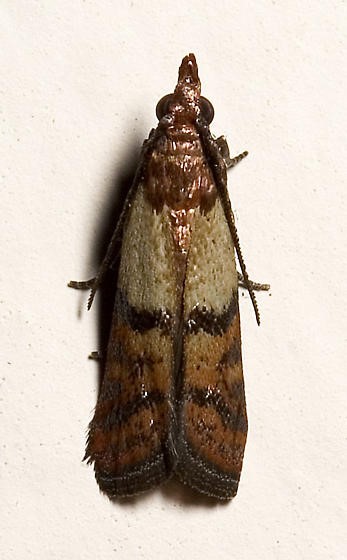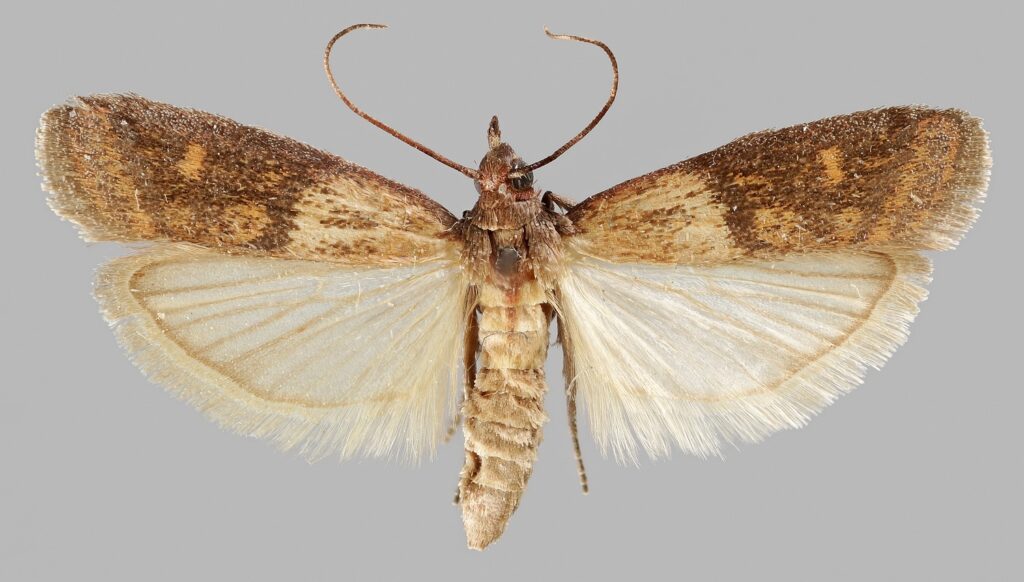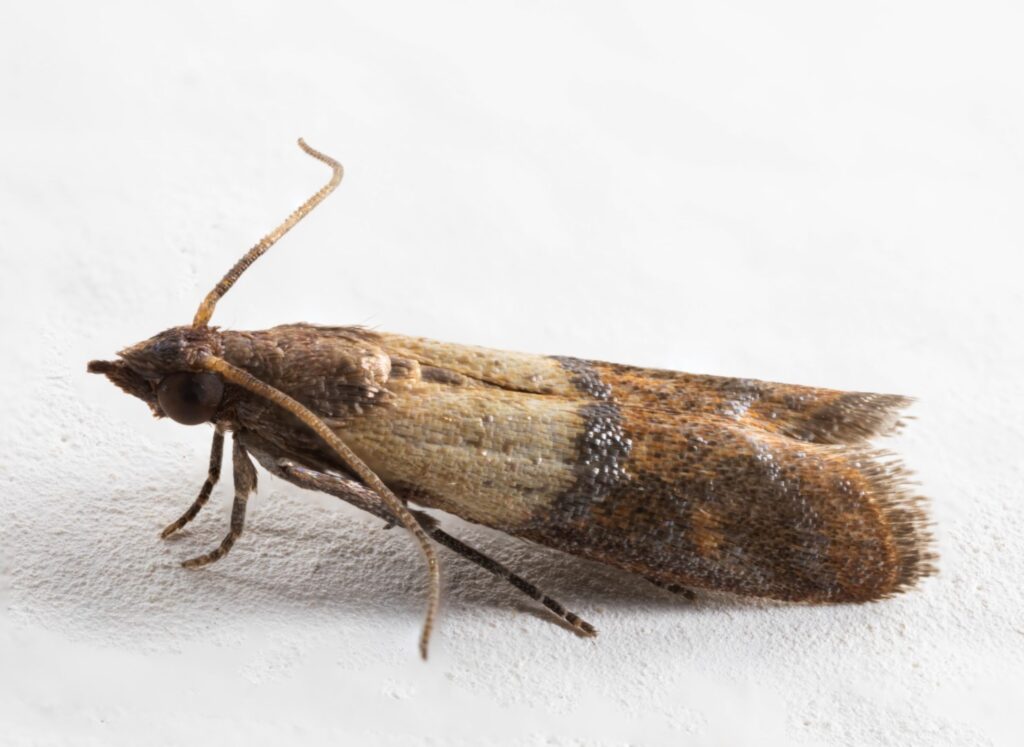Indian Meal Moth
What is an Indian Meal Moth?
The Indian meal moth (Plodia interpunctella) belongs to the Pyralidae family and is particularly known for its larvae that infest stored goods. These insects are attracted to cereals, dried fruits, nuts, and even chocolate, and their presence can lead to the loss of large quantities of food. The risks associated with the Indian meal moth include not only food contamination but also the spread of diseases due to their feeding activity.
How to Identify an Indian Meal Moth?
The Indian meal moth is recognizable by its brownish forewings adorned with distinctive shades and patterns that set it apart from other pests, while its hindwings are lighter and almost translucent, often making them easy to identify when in flight. Adults, measuring about 8 to 10 mm in wingspan, can be seen fluttering around light sources, often signaling the start of an infestation.
Signs of infestation vary and include the presence of whitish or pinkish larvae with a brown head, often found feeding inside food products, accompanied by filamentous webs that clutter infested food, making pest activity evident. Small holes in food packaging are also a clear indicator that larvae have started feeding, highlighting the urgency of intervention to prevent further damage.

Additional Information on the Indian Meal Moth
Pest Type
Insect pest particularly adapted to infesting stored products, posing a significant risk to food reserves in homes and industries.
Appearance
Adults have brownish forewings with distinctive patterns, while their larvae, whitish to pinkish, have a darker head, making them easy to identify in infested foods.
Lifespan
The complete life cycle of the Indian meal moth, from egg to adult, typically lasts 1 to 2 months, but this period can vary depending on environmental conditions like temperature and humidity.
Habitat
Thrives mainly in areas where food is stored, including kitchens, pantries, and warehouses, where it finds ideal conditions for reproduction.
Diet
Prefers a wide range of dry products, including cereals, dried fruits, nuts, and chocolate, allowing it to feed and reproduce in various environments.
Life Cycle
Capable of producing several generations per year if conditions are favorable, leading to rapid and massive infestations if not effectively controlled.
Do I Have an Indian Meal Moth Problem?
If you discover larvae in your stored foods or see adults flying around your cabinets, it is time to act. Exterminapro has the expertise needed to quickly and effectively eliminate these intruders.
Signs of an Indian Meal Moth Infestation
- Damage to Stored Products: The consumption of food by Indian meal moth larvae results in the formation of webs and the accumulation of organic waste, compromising the quality and safety of stored products.
- Presence of Adult Insects: The characteristic flight of adults around light sources or in food storage areas is an early sign of infestation that should not be ignored.
- Larvae and Webs in Food: Finding active larvae or filamentous webs within stored goods is a reliable indicator of an active infestation, necessitating immediate intervention to limit damage.


Risks Associated with Indian Meal Moths
Beyond significant economic loss due to food contamination and destruction, the Indian meal moth can also pose health risks by contaminating food with bacteria and allergens, making products not only unfit for consumption but also dangerous for sensitive individuals. The larvae can disseminate pathogenic microorganisms as they feed and move, increasing the risk of foodborne illnesses.
An uncontrolled infestation can quickly become a public health issue. Exterminapro offers professional and safe solutions to treat these infestations, using proven methods that ensure not only the elimination of pests but also the preservation of the cleanliness of your environment.
What Are the Treatments to Eliminate Indian Meal Moths?
Managing an Indian meal moth infestation requires an integrated approach, including thorough cleaning of affected areas and the use of suitable biological or chemical control methods.
Preventing Indian Meal Moth Infestation
- Secure Storage: Using airtight containers for food storage is a key preventive measure to avoid the entry and proliferation of Indian meal moths in your provisions.
- Regular Cleaning: Thoroughly cleaning storage areas, including vacuuming cabinets and shelves, is essential to eliminate potential eggs and larvae and reduce the risk of future infestation.
- Product Inspection: Carefully inspecting food products, especially newly purchased ones, for any signs of infestation can prevent the introduction of Indian meal moths into your home.
Types of Treatments for Combating Indian Meal Moths
- Pheromone Traps: These devices are a non-toxic and effective method to monitor and reduce Indian meal moth populations by capturing males, which disrupts the reproductive cycle.
- Specific Insecticides: Targeted application of insecticides by professionals can eradicate infestations at all developmental stages, from eggs to adults, ensuring complete elimination.
- Waste Management: Quickly disposing of infested products and thoroughly cleaning the affected area are crucial steps to eliminate the larvae’s food sources and prevent new infestations.
How to Permanently Eradicate Indian Meal Moths?
Eradicating Indian meal moths involves a combination of thorough cleaning, proper storage practices, and, when necessary, professional interventions. Exterminapro uses advanced methods to treat infestations, ensuring the safety of your food and your environment.
Intervention Process
How Much Does It Cost?
Get a Free Estimate
The cost of an Indian meal moth intervention can vary depending on the extent of the infestation and the chosen treatment methods. Exterminapro offers free estimates to meet your specific needs. Contact us for a consultation and regain peace of mind with safe and clean food storage.

